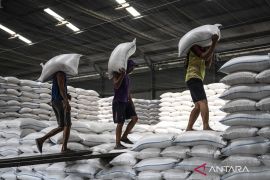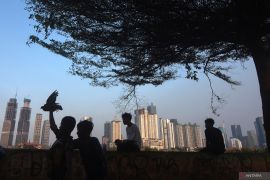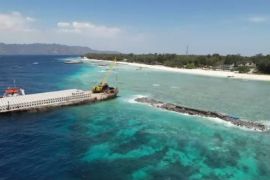After 90 minutes in the air, the CASA 212 plane begins its descent into Purpura airport in Kisar, the island with metamorphic rocks encircled by a coral terrace.
For a few minutes as the plane approaches the runway, some passengers stare out the window and look at beautiful beaches below along the coast of Kisar.
The runway threshold of Purpura airport is on a small, 30-meter high cliff that drops away into the ocean and Uhum beach, dotted with rural huts.
Johanes Tahinlaru, a local taxi driver, quoted some tourists as saying that Uhum beach is the most beautiful beach they have seen in Maluku, even in Indonesia.
Kisar has a lot to offer. Tourists visiting the island can go swimming, snorkeling, diving, spear fishing, or just stroll along the white sandy beaches of Kihar, Kiou, Nama, Malara, Tutu, Midau, Uhum, Ohinaran, Jawalan, Indeul, Lilit and many others.
They can also visit the ruins of Forth Vollenhove at Nama beach, Forth Delfthaven in Kaisama village, the ruins of Leklor old church built by Dutch in 1777 and burned by fire in 1925, or climb the hills of Daitilu, Lekwa`in, Manheri, or Mauhara to see the panoramic beauty around the island.
While climbing the hills of Lekwa`in, Manheri, and Mauhara on the south of the island, visitors can find much to enjoy; the feel of gentle breezes, the awesome grandeur of the Timor strait, separating Kisar from Timor Leste and Australia, and the song of the weed birds, magpies, friar birds (locally known as burung koli), and others.
The song of the friar birds is complex and comprises at least three elements, starting with a rapid low-pitched trill for a few seconds, and then a series of nasal, coarse, tonally complex sounds.
Kisar is one of many islands in Southwest Maluku district and, in short, there is nothing here.
"But of course, by nothing it means nothing as in the terms of not much development, but a lot of nature," local culture and tourism office spokesman Anes Dahoklory says.
No matter how remote this island is, Dahoklory notes that it is still developing its tourism sites.
Meanwhile, Oirata village community figure Lucas Wedilen said this tiny and rocky island was nameless and deserted when, long ago, Lewenmali and Asamali first arrived from Tutukei Serwaru on Leti island.
Being hungry one day, they thought of looking for something to eat. They travelled as far as Cape Loronwisi at the southeast tip of the island.
But there, Lewenmali and Asamali did not see any food. The only living beings they found were unnumbered caterpillars.
So, they "seselpain" (prayed) for the Creator: "If these verily are nothing but caterpillars from flies` eggs, the land here will be rotting when we come back after seven days; but if they are of any use, they shall have been transformed when we return."
When they returned to Loronwisi after seven days, those countless caterpillars had been transformed into thousands of "hihiyotowa" or goats.
That was the reason why, from that time, this island had been called Yotowawa, until the arrival of a Dutch ship skippered by Jan Belen in 1665.
The ship anchored near "Uwaraha Lauwar", a pitch-black rock not far from Kihar Sere, a narrow beach overlooking Timor Leste on the south of Yotowawa.
Jan Belen had no idea where he had anchored his ship, so he went to the shore of Kihar Sere and found Horsair and Mutasair, two indigenous people who were mending nets.
Eager to know the name of the island, Jan Belen asked Horsair and Mutasair, but because of language problems they thought the Dutchman asked the name of the beach.
So Horsair and Mutasair told Jan Belen that it was Kihar, but the Dutchman pronounced it "Kisar", and from that time on the name of the island has been popularly known as Kisar.
The Dutch VOC in 1665 built its military base in Kisar, and from the European outpost on the island a relatively large Indo Eurasian
community of "Mestizo from Kisar" developed and continues to this day, with surviving family names include Joostenz, Wouthuysen, Caffin, Lerrick, Peelman, Lander, Ruff, Bellmin, Belder, Coenrad, van Delsen, Schilling and Bakker.
Wedilen added that tourists and visitors to the island are amazed at its traditional arts and culture.
"Whether they are into spear fishing or just fishing, diving, swimming, snorkeling, or just strolling along the waters edge of its pristine beaches moments before the sunset, Yotowawa is the perfect escape," he noted.
According to Wedilen, Oirata village, during the past several years, has become a favorite and idyllic destination for foreign tourists who arrive by the MV Orion cruise ship from Darwin.
"In small groups with local guides the tourists were invited to explore Kisar`s history, including the architectural remnants from the Dutch period over the past 400 years, and then ushered to Oirata village," Wedilen said.
Arriving at Oirata village, the tourists were entertained with the colorful and traditional Cakalele war dance, led by Nathaniel Haratilu.
Besides, they also had the opportunity to see a number of activities, including "sopi" alcoholic drink distilling, brown sugar making from Koli palm trees, and Ikat weaving for sale.
"Magnificent! We want to stay longer here in Oirata, Kisar, but unfortunately we have very limited time. But we enjoyed our visit in Oirata, anyway," said Marieke Egan of the Netherlands.
Max McGuire, a tourist from Australia, also acknowledged that he was deeply impressed with the way the local residents made brown sugar and sopi from Koli palm trees that grow well on Kisar.
Due to the small population and remote location, the fish life and unspoilt beaches and coral reefs in Kisar are abundant.
Gabriel, an avid surfer, spear-fisher, and diver from Australia
takes the opportunity to explore the beaches and the reefs in Kisar.
"Soon upon arriving at the beach, I put on my fins, got my spear-gun ready, and swam out immediately," Gabriel said.
For him, the fish life and the color of both the fish and corals are amazing.
"Dip your head in and you will start seeing fish. A couple of undersized snapper swam over me and a shoal of smallish barracuda," Gabriel says.
While floating on the surface, he said he saw a big splash and it was the biggest barracuda he had ever seen.
"I lined it up, waited for a broadside shot and squeezed the trigger, but then it disappeared into the dark blue depth," he continued.
Gabriel had a couple other fish down, but he was becoming cold so he decided to return to shore.
"Everyday in Kisar holds new adventures and I am continually amazed at how awesome the Lord is for giving me this opportunity to visit Kisar island," he says. (*)
Reporter: Otniel Tamindael
Editor: Otniel Tamindael
Copyright © ANTARA 2012











